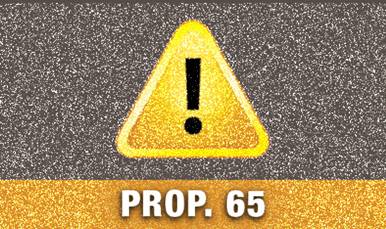
WARNING: Everything in California May Cause Cancer.
That is the likely conclusion if one were to believe every Proposition 65 warning they encounter. So ubiquitous are Prop. 65 warnings that they seamlessly blend into the California landscape.
From mall entrances to just about every conceivable consumer product, Californians are bombarded with Prop. 65 warnings to the point that it is hard to know what is not known to the state of California to cause cancer or reproductive harm.
Clearly, there are too many Prop. 65 warnings and consumers are by and large viewing them as simply “white noise.”
The agency responsible for promulgating the regulations, the Office of Environmental Health Hazard Assessment (OEHHA), agrees there is an overwarning problem.
Unfortunately, OEHHA’s proposed regulatory changes are unlikely to reduce the number of warnings and will have negative unintended consequences for businesses.
The California Chamber of Commerce is co-leading a coalition to highlight the problems with the proposed changes to the warning requirements.
Why Warn?
Companies warn under Prop. 65 because not doing so brings substantial liability, even if the exposure to a Prop. 65-listed chemical is de minimis. Rarely does defending even a frivolous lawsuit make economic sense when settling with bounty hunters is often cheaper and speedier.
Private enforcers alleging exposure to a Prop. 65-listed chemical need only to demonstrate the presence of the Prop. 65-listed chemical and include a certificate of merit. It is the business that carries the heavy burden of proving that the exposure is below the Safe Harbor Level, a highly technical and often difficult to prove analysis that rarely justifies the high cost.
Since 2010, businesses have opted to settle more than $185 million in Prop. 65 lawsuits. Even during a global pandemic, Prop. 65 enforcement attorneys have secured more than $1.1 million in fees just 30 days into 2021.
Shakedown lawsuits will inevitably continue, and companies will inevitably continue warning to reduce liability. OEHHA will not address the overwarning problem and restore meaning to Prop. 65 warnings with its proposed changes to the short form warning requirements. The proposed changes will simply result in companies spending millions more dollars to redo their warning labels, again.
Increased Costs, Liability
Proposed Change to Safe Harbor Warning Requirements Will Raise Costs on California Businesses.
OEHHA’s proposed changes to the Prop. 65 warning requirements come just two years after companies spent millions of dollars overhauling their Prop. 65 warning programs to comply with the August 30, 2018 enforcement deadline.
OEHHA provided companies with two safe harbor warning options, one of which was the short form warning allowed if the company placed the Prop. 65 warning label directly on the actual product (as opposed to the store shelf, as one example).
Companies relied on and spent millions complying with the plain language of the regulations and the agency’s written feedback to the regulated community about sizing requirements, language and placement of the warnings.
Now, two years later, OEHHA justifies these proposed changes as a way to reduce the number of warnings in the marketplace. Unfortunately, these proposed regulations will do little to meaningfully address the Prop. 65 overwarning problem because they incorrectly assume companies are overwarning because the agency provided a shorter Prop. 65 warning label option.
Changing Prop. 65 warning label programs, again, will result in additional financial impacts, confusion and legal liability for businesses at a time when they can least afford it.

